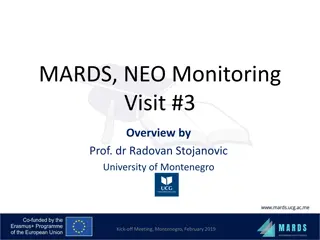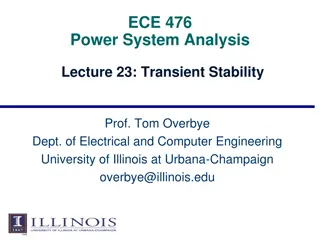
Principles of Data Analysis and ICT in University of Nigeria Nsukka Postgraduate Studies
Explore the principles of data analysis and information and communication technology (ICT) in the postgraduate studies program at the University of Nigeria, Nsukka. Topics include quantitative and qualitative data, questionnaire design, popular analytical packages, and the advantages of using SPSS for data analysis.
Download Presentation

Please find below an Image/Link to download the presentation.
The content on the website is provided AS IS for your information and personal use only. It may not be sold, licensed, or shared on other websites without obtaining consent from the author. If you encounter any issues during the download, it is possible that the publisher has removed the file from their server.
You are allowed to download the files provided on this website for personal or commercial use, subject to the condition that they are used lawfully. All files are the property of their respective owners.
The content on the website is provided AS IS for your information and personal use only. It may not be sold, licensed, or shared on other websites without obtaining consent from the author.
E N D
Presentation Transcript
UNIVERSITY OF NIGERIA, NSUKKA SCHOOL OF POSTGRADUATE STUDIES ICT AND PRINCIPLES OF DATA ANALYSIS PROF. UZOMA ODERA OKOYE University of Nigeria, Nsukka uzoma.okoye@unn.edu.ng 08163886322 Department of Social Work PGC 601
OUTLINE GOALS AND OBJECTIVES INTRODUCTION QUANTITATIVE AND QUALITATIVE DATA QUALITIES OF A GOOD QUESTIONNAIRE ORDERING OF QUESTIONS IN THE QUESTIONNAIRE WORDING OF QUESTIONS IN THE QUESTIONNAIRE POPULAR ANALYTICAL PACKAGES ADVANTAGES OF USING DATA ANALYSIS SOFTWARE SPSS AS AN ANALYTICAL TOOL PGC 601
GOALS AND OBJECTIVES The objectives of this lecture are as follows: To create a general awareness about ICT in data analysis The re-emphasise the importance of questionnaire as a data collection tool To expose students to the use of SPSS in data analysis To empower students to ask pointed questions to SPSS experts and crosscheck what was done. PGC 601
INTRODUCTION To have a good data to analyze you must first of all collect quality data In order to collect quality data, you must have a good instrument Data collected can be in qualitative or quantitative form PGC 601
QUALITATIVE DATA QUALITATIVE DATA is a categorical measurement expressed not in terms of numbers, but rather by means of a natural language description Sometimes qualitative data can provide descriptive information that may corroborate some of the findings from the quantitative method Provide insights and a greater depth of meaning and understanding of findings. Provide the needed tools for prompts, probes and the observation of certain nuances that underlie some of the sensitive and personal issues to be studied. Examples of qualitative instrument include interview guide PGC 601
QUANTITATIVE DATA Quantitative research deals with measurable and quantifiable aspects of phenomenon under study. It focuses on the questions to what extent? By how much? What relationship exists between factors? What causes particular processes or situations? Quantitative research is concerned with the collection and analysis of data in numeric form Quantitative data can be used to determine the size, distribution, and association of certain variables in a study population. How many? How often? and How significant? are important questions requiring fairly simple statistical techniques. Questionnaire is a typical example. PGC 601
Qualities of a good questionnaire Every questionnaire must have a covering letter that will tell your respondents who you are and the purpose of the questionnaire The questionnaire should be divided into section Each section must have general and specific guidelines to respondents Remember the data will be coded so put the coding into consideration when developing the questionnaire PGC 601
EXAMPLE Which of the following do you think is the one best way to stop the spread of HIV/AIDS Early marriage ( ) Prayers and fasting ( ) Having only one sex partner ( ) Use of condoms ( ) 1. 2. 3. 4. THIS QUESTION WAS DESIGNED WITH CODING IN MIND PGC 601
Ordering of questions in the questionnaire Do not ask sensitive questions first. Eg Age should not be the first question. Arrange the questions in content areas Embarrassing questions should come last PGC 601
Wording of questions in the questionnaire You must make the questions to be simple The questions should be short. Avoid emotional language and prestige bias. Avoid asking questions that are beyond the capabilities of respondents. Avoid the use of scientific abbreviations, jargon and slang unless you are using a specialized population as your respondents. Know when to ask direct and indirect questions In using close ended, make sure that there response categories are exhaustive and also mutually exclusive Avoid leading questions. Avoid ambiguous questions. Avoid double barrel questions PGC 601
WHAT IS DATA ANALYSIS? Data analysis is the process of extracting information from data. It involves multiple stages including establishing a data set, preparing the data for processing, applying various statistical tools, identifying key findings and creating reports There are a variety of specific data analysis method, some of which include descriptive, inferential, predictive, casual etc PGC 601
POPULAR ANALYTICAL PACKAGES Statistical Package for Social Sciences (SPSS), Epidemiological Information (Epi Info), Microsoft Excel STATA SAS PGC 601
ADVANTAGES OF USING DATA ANALYSIS SOFTWARE Reduce/eliminate errors in calculation Data management, e.g., add variables & observations, recode variables, etc. Graphical utilities Multiple users can work with the same data file Faster, more efficient PGC 601
Generic Features of SPSS Raw data are organized in tabular format with each observation having a row and each variable its own column (i.e., observation by attribute) Data, command, & output files are distinct and saved as such Menu or syntax can be used to create graphical displays Variables have to be identified in a certain format prior to analysis (most likely numeric, not string ) Extensive help menus PGC 601
USING SPSS TO ANALYZE YOUR DATA The first thing to do is to number your questionnaire serially Why? For quality control and to make corrections easier The next thing to do is to develop value labels PGC 601
SPSS VARIABLE PAGE PGC 601
Example of a Questionnaire Instruction:Please carefully read the questions below and provide a response to each question by ticking ( ) to your chosen option(s) from the alternatives provided. Where there are no options, you are free to indicate other responses as it applies to you. Section A: Socio-Demographic Information 1. Sex: (1) Male [ ] (2) Female [ 2. How old were you during your last birthday? ____________________________ ] 3. Marital status: (1) Single [ (4) Divorced [ 4. Occupation: (1) Farmer [ (4) Civil Servant [ ] (5) Student [ ], 5. Educational Status: (1) No formal education [ (3) Primary education non-completed [ ], (4) Secondary education completed[ ] (5) Secondary education non- completed [ ], (6) Tertiary education completed[ ], (7) Tertiary education non-completed [ ], (8) Don t know/No answer [ ] 6. Religion: (1) Catholic [ ], (2) Protestants [ ], (3) Pentecostal [ ], (4) Islam [ ], (5) African Traditional Religion [ ], (6) Others specify ____________________ ], ] (5) Widowed [ ]. ], (2) Married [ ], (3) Separated [ ], (2) Trader [ ], (3) Artisan [ ], (6) Unemployed [ ], (7) Others specify _______ ], (2) Primary education completed [ ], PGC 601
EXAMPLE OF A VALUE LABEL WINDOW PGC 601
ANOTHER EXAMPLE PGC 601
AN EXAMPLE OF VALUE LABELS PGC 601
AN SPSS DATA PAGE PGC 601
COMPLETED SPSS DATA PAGE PGC 601
HOW TO OBTAIN FREQUENCY DISTRIBUTION TABLES PGC 601
HOW TO OBTAIN FREQUENCY DISTRIBUTION TABLES CONTD PGC 601
SAMPLE OF SPSS OUTPUT PGC 601
REDRAWING SPSS OUTPUT IN WORD PGC 601
QUESTIONS AND COMMENTS WHAT I HAVE LEARNT FROM THE WORKSHOP Want to share? PGC 601
THANK YOU FOR LISTENING PGC 601





















